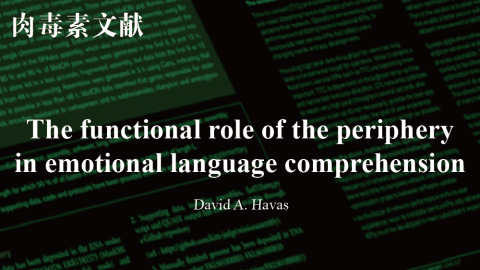
- 4154人
- 分享收藏
The functional role of the periphery in emotional language comprehension
David A. Havas
简介
【 文献重点摘要 】
Language can impact emotion, even when it makes no reference to emotion states. For example, reading sentences with positive meanings (“The water park is refreshing on the hot summer day”) induces patterns of facial feedback congruent with the sentence emotionality (smiling), whereas sentences with negative meanings induce a frown. Moreover, blocking facial afference with botox selectively slows comprehension of emotional sentences. Therefore, theories of cognition should account for emotion-language interactions above the level of explicit emotion words, and the role of peripheral feedback in comprehension. For this special issue exploring frontiers in the role of the body and environment in cognition, we propose a theory in which facial feedback provides a context-sensitive constraint on the simulation of actions described in language. Paralleling the role of emotions in real-world behavior, our account proposes that (1) facial expressions accompany sudden shifts in wellbeing as described in language; (2) facial expressions modulate emotional action systems during reading; and (3) emotional action systems prepare the reader for an effective simulation of the ensuing language content. To inform the theory and guide future research, we outline a framework based on internal models for motor control. To support the theory, we assemble evidence from diverse areas of research. Taking a functional view of emotion, we tie the theory to behavioral and neural evidence for a role of facial feedback in cognition. Our theoretical framework provides a detailed account that can guide future research on the role of emotional feedback in language processing, and on interactions of language and emotion. It also highlights the bodily periphery as relevant to theories of embodied cognition.
Keywords
embodied cognition, language comprehension, simulation, facial feedback, emotion, botox, motor control, constraint satisfaction
语言可以影响情绪,即使它没有提到情绪状态。例如,阅读具有积极意义的句子(“炎热的夏日,水上公园令人神清气爽”)会导致面部反馈模式与句子的情绪性(微笑)一致,而具有负面意义的句子会导致皱眉。此外,用肉毒杆菌毒素阻断面部传入会选择性地减慢对情绪化句子的理解。因此,认知理论应该考虑外显情感词水平以上的情感-语言交互作用,以及外围反馈在理解中的作用。对于探索身体和环境在认知中作用的前沿这一特殊问题,我们提出了一种理论,即面部反馈对用语言描述的动作的模拟提供了上下文敏感的约束。与情绪在现实世界行为中的作用类似,我们的账户提出:(1)面部表情伴随着语言中描述的幸福感的突然变化;(2)面部表情调节阅读过程中的情绪行为系统;(3)情绪行为系统为读者有效模拟随后的语言内容做好准备。为了给理论提供信息并指导未来的研究,我们概述了一个基于内部模型的电机控制框架。为了支持这一理论,我们从不同的研究领域收集证据。从情绪的功能观点出发,我们将这一理论与行为和神经证据联系起来,以证明面部反馈在认知中的作用。我们的理论框架对情绪反馈在语言加工中的作用以及语言与情绪的相互作用的研究提供了详细的说明。它还强调身体外围与具身认知理论相关。
关键词
具身认知,语言理解,模拟,面部反馈,情绪,肉毒杆菌毒素,运动控制,约束满足



